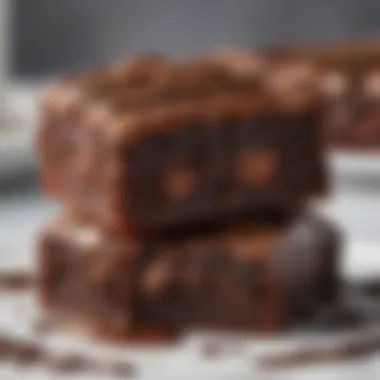The Intricate World of Brownies: Origins & Variations


Intro
Brownies are a timeless treat, beloved by many for their rich, chocolatey flavor and satisfying texture. Originating in the United States, these desserts have evolved significantly over time. If you are curious about the world of brownies, this article will guide you through every layer of their story, from their historical roots to innovative preparations found in modern kitchens.
By exploring the diverse forms brownies can take, as well as the essential techniques involved in baking them, this piece seeks to provide both novice and seasoned bakers with new insights. The quest for the perfect brownie is an endeavor that blends culinary art with science. Perfecting the balance of ingredients can make all the difference.
Recipe Overview
Dish Description
Brownies are typically a dense, fudgy dessert, made with basic ingredients such as flour, sugar, butter, eggs, and chocolate. Their texture may range from chewy to cakey, largely influenced by the ratio of these ingredients. Noted for their rich flavor, brownies may also incorporate nuts, chocolate chips, or various flavorings.
Cuisine Type
Brownies belong to American cuisine. However, their influence has spread globally, inspiring numerous adaptations and new recipes across different cultures.
Ingredients List
Detailed Ingredients
To prepare classic brownies, you will need:
- All-purpose flour
- Unsweetened cocoa powder
- Sugar
- Brown sugar
- Eggs
- Unsalted butter
- Vanilla extract
- Salt
Substitutions and Variations
There are many ways to customize your brownies. For example:
- Flour Alternatives: Use almond flour or coconut flour for a gluten-free option.
- Sugar Substitutes: Consider agave syrup or erythritol for lower-sugar recipes.
- Add-ins: Enhance the flavor by adding nuts, chocolate chunks, or fruits like raspberries.
The exploration of brownies does not end with their ingredients. It also involves investigating the baking techniques and the science that ensures a successful bake.
Baking is as much about the process as it is about the ingredients. Understanding how flavors and textures interact is crucial for achieving the perfect brownie.
As the article progresses, it will delve into more detailed aspects of brownie-making, including essential techniques, innovative recipe variations, and the cultural significance that these desserts hold in contemporary cuisine.
Foreword to Brownies
Brownies are more than just a popular dessert; they represent a blend of rich history, cultural significance, and culinary evolution. This section serves as an entry point into the multifaceted world of brownies. Understanding brownies means appreciating their texture, flavor, and the myriad ways they can be enjoyed. It emphasizes their appeal across generations and highlights the benefits of embracing a classic yet adaptable dessert in any culinary repertoire.
Historical Context
The origins of brownies are somewhat hazy, yet they can be traced back to the late 19th century in the United States. It is widely accepted that they emerged around the time of the Chicago World’s Fair in 1893. The first known published recipe appeared in a cookbook by Fannie Farmer, which featured a simple combination of chocolate, flour, butter, and sugar. This recipe reflected daily baking practices at the time, which were influenced by broader European baking traditions.
Brownies evolved from their dense, fudgy beginnings into various styles that cater to diverse palates. Throughout the decades, they adapted to changing tastes and ingredient availability, leading to various modern interpretations and innovations. Such evolution illustrates the resilience of brownies within the culinary landscape, reflecting societal changes over time.
Cultural Significance
Brownies hold an esteemed place within American culture and beyond. They are not just a dessert; they are often a symbol of comfort and celebration. Shared during gatherings, parties, and holidays, they create a sense of unity and warmth. From school bake sales to family gatherings, brownies signify a homemade touch that resonates with nostalgia.
Additionally, they have been embraced internationally, allowing for a variety of adaptations based on local flavors and ingredients. For instance, in many cultures, brownies are infused with unique spices or paired with traditional sweets, underscoring their versatility. This cultural significance extends to their representation in literature and media, further embedding brownies into the societal fabric.
"Brownies are a canvas for creativity, each batch a story of culinary evolution and personal expression."
Their enduring popularity emphasizes their importance as both a dessert and a cultural artifact, bridging generations with each bite.


Fundamental Ingredients
Understanding the fundamental ingredients in brownies is essential for both novice and experienced bakers. Each ingredient plays a significant role in determining the texture, flavor, and overall quality of the final product. The choices made in this phase can lead to subtle, yet impactful differences in the end result. Thus, having a solid grasp on these ingredients is crucial to mastering the art of brownie-making.
The Role of Chocolate
Chocolate is the heart of any brownie recipe. Choosing the right type of chocolate can drastically alter the flavor profile. Cocoa powder, for example, provides a rich, deep flavor while also contributing to the brownies’ structure. In contrast, melted chocolate adds moisture and creates a denser, fudgier texture.
Quality matters here. Using high-quality chocolate, like Ghirardelli or Callebaut, ensures a more complex flavor comes through. Furthermore, different levels of cocoa content in chocolate can emphasize or tone down the sweetness, allowing bakers to customize their treats. When selecting chocolate, it's important to consider the intended taste and texture.
Flour Variations
Flour often has a major influence on the texture of brownies. All-purpose flour is the most common choice, providing a sturdy base. However, different flours can contribute distinct characteristics:
- Cake flour results in a lighter, airier texture.
- Whole wheat flour can add nuttiness and increase nutritional value.
- Gluten-free flour blends ensure accessibility for those with dietary restrictions.
Each type has its purpose, and a well-informed baker can utilize these variations to enhance their brownies’ texture and health aspects.
Sugar Types and Their Effects
The type of sugar used is another key element. Granulated sugar is generally the main choice, but alternatives like brown sugar or coconut sugar can introduce different flavors and moisture levels. Brown sugar adds a hint of molasses, providing chewiness and depth. Conversely, less common sugars like agave might offer unique flavors. Always consider how each sugar alters both taste and texture.
Eggs and Moisture Content
Eggs serve more than just a binding role in brownies. They significantly influence moisture and richness. The number of eggs can adjust the density. For instance, using more eggs can result in a cakier texture while fewer leads to a denser brownie. It is also important to consider the temperature of the eggs; room temperature eggs incorporate better into batters, ensuring a smooth mixture. This enables an even baking process.
Butter versus Oil
The choice between butter and oil impacts both flavor and texture. Butter is favored for its rich flavor and ability to create a tender crumb. Many chefs prefer unsalted butter to control salt levels in the recipe. On the other hand, oil provides a moist texture and tends to create a fudgier result. Certain oils like coconut oil also impart their own unique flavors. Each fat brings its distinct qualities, and understanding these differences can elevate brownie recipes to new heights.
Classic Brownie Recipes
Classic brownie recipes form the cornerstone of brownie-making. Their significance lies not only in their popularity but also in their ability to showcase the versatility of brownies as a dessert. By focusing on specific elements across various classic recipes, bakers can explore different textures and flavors. Whether one prefers fudgy, cake-like, or chewy brownies, each recipe offers distinct characteristics that can transform basic ingredients into something extraordinary. Understanding these variations enhances the baking experience and allows for better creativity in the kitchen.
Fudgy Brownies
Fudgy brownies are often favored for their rich and dense texture. The key to achieving this consistency is the amount of chocolate and fat used in the recipe. High-quality chocolate is essential; it should be melted before adding to the mix. Typically, a larger proportion of butter contributes to their fudgy quality.
Important considerations when making fudgy brownies include:
- Chocolate Quality: Always opt for high-cocoa content chocolate to enhance flavor.
- Baking Time: Over-baking can lead to a dry texture. The brownies should appear slightly underbaked as they firm up while cooling.
- Eggs: More eggs often lead to moisture, giving a richer texture.
The fudgy brownie is a testament to the beauty of simplicity coupled with quality.
Cake-like Brownies
In contrast, cake-like brownies possess a lighter texture, resembling a cross between traditional brownies and cake. They often require a bit more flour and leavening agents than their fudgy counterparts. This structure allows for a fluffier bite, making them ideal for those who prefer something less dense.
When crafting cake-like brownies, consider the following:
- Leavening Agents: Baking powder or baking soda can provide the lift needed for a cake-like result.
- Mixing Technique: Creaming butter and sugar before adding other ingredients introduces air, aiding in a lighter texture.
- Serving Suggestions: Dusting with powdered sugar can enhance the presentation and add a touch of sweetness.
Chewy Brownies
Chewy brownies strike a balance between fudgy and cake-like textures. They offer a satisfying chewiness while still being rich. This style is achieved by adjusting the sugar content and the ratios of butter and flour. Moreover, using brown sugar instead of white sugar can contribute to a chewier finish.
Key aspects to consider for chewy brownies include:


- Sugar Type: Brown sugar has more moisture, contributing to their chewiness.
- Butter Temperature: Ensuring the butter is at room temperature allows it to incorporate better into the batter.
- Thickness: Baking in a smaller pan can create a thicker brownie, enhancing the chewy texture.
By mastering classic brownie recipes, one can cultivate an environment of exploration and creativity in the baking process. Whether it's the irresistible fudgy variant, the light and airy cake-like brownie, or the satisfyingly chewy style, each recipe enriches the delicious world of brownies.
Innovative Brownie Variations
Innovative brownie variations play a vital role in the landscape of dessert culture. These adaptations do not only cater to specific dietary needs but also introduce unexpected flavors and textures. They reflect the evolving nature of food preferences and the significance of inclusivity in culinary practices. By exploring different techniques and alternative ingredients, bakers can expand their creativity. This section aims to illuminate how these innovative approaches can elevate brownies beyond traditional recipes.
Gluten-Free Brownies
Gluten-free brownies are essential for those with gluten intolerance or celiac disease. The demand for gluten-free options has surged in recent years as awareness of dietary restrictions becomes more prevalent. Techniques to create gluten-free brownies typically involve replacing traditional wheat flour with alternatives such as almond flour, coconut flour, or gluten-free all-purpose flour. These substitutions can influence the texture and flavor profile of brownies.
- Almond Flour: This nut-based flour yields a moist and rich brownie. Using almond flour can enhance the nutty flavor, adding depth to the dessert.
- Coconut Flour: This ingredient is highly absorbent, so it typically requires additional liquids in the recipe. When balanced correctly, it can produce a unique texture that is both chewy and soft.
- Gluten-Free All-Purpose Flour: This blend is designed for easy substitution in traditional recipes. It's especially useful for those transitioning to gluten-free baking.
Experimenting with these flours allows bakers to offer gluten-free brownies without compromising flavor.
Vegan Brownie Alternatives
Vegan brownie alternatives cater to those who follow a plant-based diet. The essence of a vegan brownie is to replace animal-based ingredients without sacrificing taste. Common substitutions include:
- Eggs: Flaxseed meal or chia seeds can be used to replace eggs. Mixing one tablespoon of either with three tablespoons of water until it thickens creates a suitable egg substitute.
- Butter: Coconut oil or vegan margarine is a standard alternative to butter. Both options maintain richness while adhering to vegan diets.
- Milk: Almond milk, oat milk, or soy milk serve as suitable substitutes to bring moisture.
Creating vegan brownies can introduce new flavors and textures, prompting bakers to think outside the box.
Brownie Swirls and Layered Techniques
Brownie swirls and layered techniques offer a creative twist on conventional brownie recipes. These methods can transform a straightforward dessert into a visually stunning experience, enticing both the palate and the eyes. For swirls, combinations of ingredients like cream cheese, caramel, or different flavored batters can be incorporated. The process entails:
- Division of Batter: Making two or more different batters allows for color contrast and flavor differentiation.
- Swirling: The batters can be gently swirled together using a knife or skewer to create a marbled effect, enhancing both appearance and taste.
Layered brownies often include added fillings like ganache, fruits, or nut butters between brownie layers. This approach yields a rich and indulgent dessert.
Ultimately, innovative brownie variations enable personalized baking experiences that align with diverse diets and preferences. By exploring gluten-free and vegan options, as well as swirling techniques, the matrix of brownies expands, inviting creativity and inclusivity into every kitchen.
The Science Behind Brownies
Understanding the science behind brownies is vital for both bakers and enthusiasts seeking to perfect this beloved treat. The process of baking is not merely an art; it involves chemical reactions that transform raw ingredients into the delicious squares many enjoy. By grasping these scientific principles, bakers can influence texture, taste, and overall quality, enabling them to create the ideal brownie every time.
Understanding Baking Chemistry
Baking brownies combines various ingredients in a way that produces distinct flavors and textures. Key components include flour, sugar, eggs, and chocolate. The interaction between these ingredients is what creates the final product. For example, the proteins in flour, known as gluten, develop when mixed with wet ingredients. This gluten structure is essential for providing structure but must be balanced carefully to avoid dry or tough brownies. Too much mixing can lead to overdevelopment of gluten, while insufficient mixing can prevent proper rise and density.
In addition, sugar plays a significant role beyond sweetness. It also affects the moisture content and tenderness of brownies. The Maillard reaction, which occurs between sugars and proteins during baking, further enhances flavor and color. Understanding these reactions helps bakers control sweetness, moisture, and overall flavor complexity.
Achieving Desired Textures
Brownies can range from fudgy to cake-like, and achieving the desired texture involves precise manipulation of ingredients and baking techniques. The fat used, whether butter or oil, significantly influences texture. Butter introduces air during creaming, leading to a lighter texture, whereas oil results in denser and moister brownies.
The ratio of flour to eggs also plays a crucial role. More eggs can make brownies richer, while additional flour typically yields a cakier result. Monitoring bake time is necessary; under-baking can produce a gooey center, while over-baking leads to dryness. Each element must be adjusted based on the desired outcome, making the understanding of these principles beneficial for achieving perfect textures.
The Role of Temperature in Baking
Temperature is a critical factor in baking brownies, influencing both ingredient reaction rates and final outcomes. The temperature of ingredients, such as eggs and butter, can affect how they combine and function. Using room temperature ingredients generally results in better emulsification, leading to a smoother batter.
Oven temperature is equally important. Baking brownies at a consistent temperature allows for proper rising and setting. Fluctuations can cause uneven results, such as a cracked top or undercooked center. Additionally, chilling the batter before baking can intensify flavors and improve texture. The science involved shows that controlling temperature and understanding its effects can elevate the brownie-making process significantly.


"Baking is not merely an art; it involves chemical reactions that transform raw ingredients into the delicious squares many enjoy."
Serving and Pairing Suggestions
Serving and pairing suggestions for brownies play a key role in enhancing the overall dessert experience. The way brownies are served can elevate their appeal and complement their rich flavors. Understanding how to pair brownies with various accompaniments allows bakers and dessert enthusiasts to explore innovative ways to enjoy this treat. This section will focus on the importance of complementary flavors and presentation techniques, emphasizing the execution that can make a simple brownie a show-stopper.
Complementary Flavors
The flavor profile of brownies is inherently versatile. Therefore, knowing which flavors can complement them enriches the tasting experience. Common pairings include:
- Vanilla Ice Cream: The creamy texture and mild sweetness of vanilla ice cream balances the intense chocolate flavor.
- Caramel Sauce: Drizzling warm caramel over brownies introduces a luxe sweetness and contrasting texture.
- Fruit Garnishes: Fresh berries such as raspberries or strawberries add a tartness that cuts through the richness, while citrus fruit can brighten the dish.
- Nuts: Toasted nuts provide a crunchy contrast and additional depth.
These pairings not only enhance the brownie’s attributes but also cater to varying tastes. The right combinations can transform a straightforward brownie into a gourmet treat.
Presentation Techniques
The visual aspect of serving brownies is just as important as their taste. Here are some effective techniques to present brownies:
- Layering and Stacking: Arrange brownies in layers on a plate or stack them for a statuesque appearance. This technique visually implies indulgence.
- Dusting with Powdered Sugar: A sprinkle of powdered sugar can create a simple yet elegant touch, making brownies look refined.
- Sauce Drizzle: Incorporate a drizzle of chocolate or fruit sauce on the plate for an artistic effect, adding both flavor and design.
- Use of Dessert Plates: Serving brownies on unique plates can add to their overall aesthetic. Consider using slate or wooden serving boards for a rustic feel.
Presentation is an art form that can elevate even the most basic dessert into something special, making the dessert not just a treat but an experience.
"Taste is essential, but presentation elevates dessert into art."
In summary, serving suggestions and pairing options contribute significantly to the enjoyment of brownies. Understanding and applying complementary flavors alongside thoughtful presentation can turn a delicious brownie into an unforgettable culinary creation.
Brownies in Contemporary Cuisine
The reimagining of brownies within contemporary cuisine showcases their remarkable adaptability and continuing relevance in the dessert world. Food lovers today are drawn to the various interpretations of this classic treat, influenced by trends in dietary preferences and culinary creativity.
Trends in Dessert Offerings
As dining experiences become more focused on unique and diverse flavors, brownies are being reinvented. Many chefs and home bakers are experimenting with textures and tastes that were not traditionally associated with brownies.
- Artisanal and Gourmet Brownies: People are gravitating towards artisanal products that emphasize high-quality ingredients. For instance, adding single-origin chocolate or incorporating organic produce is becoming more common.
- Health-Conscious Options: With nutritional awareness on the rise, brownies have also seen a shift towards healthier ingredients. For example, alternatives like almond flour or coconut sugar are used to appease health-conscious consumers. Many bakeries now offer options with reduced sugar or use sweeteners that do not impact blood sugar levels as severely as refined sugar.
- Shareable Desserts: There's a trend towards desserts that cater to communal eating experiences. Brownies now often come in larger, shareable formats or as part of dessert platters to fit the dining style of sharing among friends.
Fusion Desserts
The fusion dessert movement further highlights the versatility of brownies. Chefs are combining elements from various cuisines to create unique flavors and presentations. This means brownies are no longer just a standalone treat but part of an exciting cross-cultural amalgamation.
- Brownie Sushi: This perfect blending sees the traditional brownie rolled with layers of cream or fruit to resemble sushi, appealing visually and tasting delightful.
- Global Ingredients: Using spices, fruits, and nuts from different cultures is common. Matcha, for instance, is incorporated into brownies for an Asian twist, contrasting the rich chocolate flavor.
- Savory and Sweet Combinations: There’s a remarkable trend of blending sweet and savory. Brownies infused with chili or topped with sea salt balance the decadent sweetness with a savory touch.
In summary, brownies serve not only as a nostalgic treat but also as a canvas for culinary exploration and innovation in contemporary cuisine.
The ongoing evolution of brownies reflects broader trends in the culinary world where tradition meets innovation. From health-conscious adaptations to inventive fusion desserts, the brownie remains a beloved dessert while continually evolving to meet the demands of today's diverse palates.
Culmination
In this exploration, the appeal of brownies is evident in various dimensions. The conclusion serves to encapsulate the essence of brownies as a beloved treat that transcends time and cultural boundaries.
The Timeless Appeal of Brownies
Brownies offer a unique blend of flavor, texture, and versatility that captures the heart of dessert enthusiasts. Their place in history reflects not only a culinary evolution but also a deep-seated cultural significance.
Key elements contributing to the timeless nature of brownies include:
- Versatility: Brownies can be adapted to suit a wide variety of dietary preferences, such as gluten-free and vegan.
- Texture and Flavor: The balance between fudgy and cakey textures ensures that there is a brownie for every palate. The rich chocolate flavor remains a constant, appealing to all ages.
- Presentation: Brownies can be simple or elevated through various toppings and decorations, making them suitable for casual gatherings or formal events.
Culinary exploration also reveals insights into the science behind brownie-making. Understanding how ingredients interact can help both novice and experienced bakers achieve perfection.
"The appeal of brownies is not merely in their taste but in their ability to bring people together through shared experiences."
Ultimately, the fascination with brownies remains strong due to their adaptability, rich flavor, and the nostalgia they evoke. Exploring the depths of brownies encourages both creativity and tradition within the kitchen.







